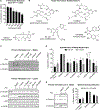A High-Throughput Assay for Collagen Secretion Suggests an Unanticipated Role for Hsp90 in Collagen Production
- PMID: 29676157
- PMCID: PMC6231715
- DOI: 10.1021/acs.biochem.8b00378
A High-Throughput Assay for Collagen Secretion Suggests an Unanticipated Role for Hsp90 in Collagen Production
Abstract
Collagen overproduction is a feature of fibrosis and cancer, while insufficient deposition of functional collagen molecules and/or the secretion of malformed collagen is common in genetic disorders like osteogenesis imperfecta. Collagen secretion is an appealing therapeutic target in these and other diseases, as secretion directly connects intracellular biosynthesis to collagen deposition and biological function in the extracellular matrix. However, small molecule and biological methods to tune collagen secretion are severely lacking. Their discovery could prove useful not only in the treatment of disease, but also in providing tools for better elucidating mechanisms of collagen biosynthesis. We developed a cell-based, high-throughput luminescent assay of collagen type I secretion and used it to screen for small molecules that selectively enhance or inhibit that process. Among several validated hits, the Hsp90 inhibitor 17-allylaminogeldanamycin (17-AAG) robustly decreases the secretion of collagen-I by our model cell line and by human primary cells. In these systems, 17-AAG and other pan-isoform Hsp90 inhibitors reduce collagen-I secretion post-translationally and are not global inhibitors of protein secretion. Surprisingly, the consequences of Hsp90 inhibitors cannot be attributed to inhibition of the endoplasmic reticulum's Hsp90 isoform, Grp94. Instead, collagen-I secretion likely depends on the activity of cytosolic Hsp90 chaperones, even though such chaperones cannot directly engage nascent collagen molecules. Our results highlight the value of a cell-based high-throughput screen for selective modulators of collagen secretion and suggest an unanticipated role for cytosolic Hsp90 in collagen secretion.
Conflict of interest statement
The authors declare that they have no conflicts of interest with the contents of this article.
Figures





References
-
- Brinckmann J (2005) Collagens at a glance, Top. Curr. Chem. 247, 1–6.
-
- An B, Lin YS, and Brodsky B (2016) Collagen interactions: Drug design and delivery, Adv. Drug Deliv.Rev. 97, 69–84. - PubMed
-
- Heino J (2007) The collagen family members as cell adhesion proteins, Bioessays 29, 1001–1010. - PubMed
-
- Ishikawa Y, and Bachinger HP (2013) A molecular ensemble in the rER for procollagen maturation, Biochim. Biophys. Acta 1833, 2479–2491. - PubMed
Publication types
MeSH terms
Substances
Grants and funding
LinkOut - more resources
Full Text Sources
Other Literature Sources
Miscellaneous

